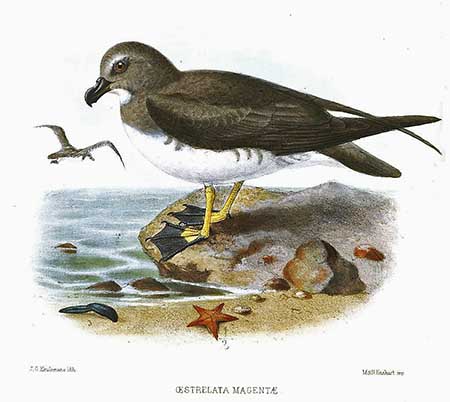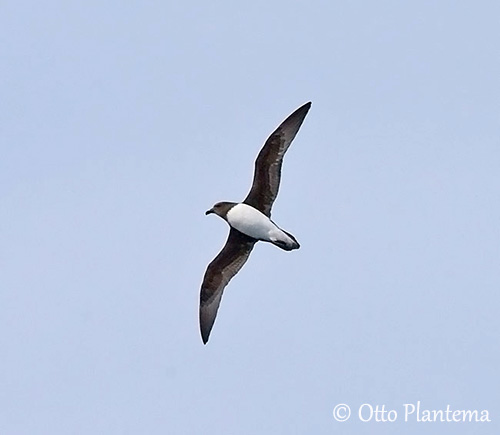
Fr: Pétrel de Magenta
Ang: Magenta Petrel
Maori: Taiko
All: Magentasturmvogel
Esp: Petrel Taiko
Ita: Petrello della Magenta
Nd: Magentastormvogel
Sd: Magentapetrell
Photographer:
Otto Plantema
Trips around the world
Illustration:
John Gerrard Keulemans (1842-1912)
Ornithological Miscellany. Volume 1
Text by Nicole Bouglouan
Sources:
HANDBOOK OF THE BIRDS OF THE WORLD vol 1 by Josep del Hoyo-Andrew Elliot-Jordi Sargatal - Lynx Edicions - ISBN: 8487334105
A Complete Guide to Antarctic Wildlife by Hadoram Shirihai and Illustrated by Brett Jarrett - Edited by Guy M. Kirwan - ALUL.A Press Oy, Finland - ISBN 9519894705
BirdLife International (BirdLife International)
New Zealand birds and birding (Narena Olliver)
New Zealand bird status between 2008 and 2012
Wikipedia, the free encyclopaedia
Ocean Wanderers "Ride the Wave"
Marine Ornithology - Contributions concerning international seabird science and conservation
Page family Procellariidae
Summary cards
Magenta Petrel
Pterodroma magentae
Procellariiformes Order – Procalleriidae Family
INTRODUCTION:
The Magenta Petrel was considered extinct. The introduced mammalian predators were the main cause of the decline. But the discovery of bones in Moriori and Maori midden material indicates that Taiko was an important component of their diet, and was heavily hunted for food. The deforestation on the Chatham Islands was another cause of the decline.
The Magenta Petrel was rediscovered in 1978 on SW Chatham Islands. The first burrows were found 10 years later. Then, by 1999, 20 years after the rediscovery of the species, 23 burrows were found.
The comeback of this species is progressing slowly, and in 2004, there were 120 birds with 15 breeding pairs. This small population is slowly increasing, thanks to intensive conservation efforts.
The Magenta Petrel is endemic to the Chatham Islands.
DESCRIPTION OF THE BIRD:
Biometrics:
Length: 38-40 cm
Wingspan: 102 cm
Weight: 450 g
The adult has dark grey and white plumage.
Head and upperparts are dark brownish-grey, including upperwing and uppertail.
The underparts are white, but neck and upper breast are dark. In some birds, the chin may show a white patch. The underwing is dark grey-brown. The undertail is white.
On the dark head, the feathers can be slightly paler around the base of the bill and on the forehead. Lores and eye’s area are blackish.
The stout, sharply hooked bill is black with conspicuous tubed nostrils. The eyes are dark brown. The legs are dull pink, whereas toes and webs are black.
Both sexes are similar.
The juvenile resembles adult, but its appearance depends on the freshness of its plumage.

John Gerrard Keulemans
(1842-1912)
RANGE:
The Magenta Petrel breeds only on the main island of the group. During the breeding season, it forages south and east of the colonies over thousands of kilometres.
During winter, it occurs across the Pacific Ocean, from Tasman Sea to South America, and also in tropical seas.
HABITAT:
The Magenta Petrel frequents the forests in the southern plateau, up to 5 kilometres inland. It breeds under the tall trees in dense forest and under tree ferns too. It often nests on slopes and valley floor, near streams.
CALLS AND SONGS: SOUNDS BY XENO-CANTO
The Magenta Petrel produces a long moaning “ooooorr” or “uuuur” while flying. It is usually silent at sea, but on the ground and in flight, it gives shrill cries “oor-wick oor-wick” especially while passing over the colonies at night. Squeaky calls can be heard from inside the burrows.
BEHAVIOUR IN THE WILD:
The Magenta Petrel feeds mainly on fish and squid and on crustaceans too. It is often solitary at sea, and it does not follow the fishing boats. Most of the squid is captured at night.
It feeds mainly on the wing by “dipping” while in flight. It does not dive and rarely alights on the water.
There is little information about the breeding behaviour of the Magenta Petrel. It is a solitary or loosely colonial breeder. It nests in self-excavated burrow under forest trees or ferns. The sexual activities occur inside the burrow. They probably perform aerial displays and chases like other petrels, but more information is needed.
The Magenta Petrel disperses across the Pacific Ocean during winter, and it occurs from the Tasman Sea to South America off Chile, and in tropical seas.
It has relatively slow flight. It flies usually at moderate heights, with short arcs and glides even in strong breezes.

REPRODUCTION OF THIS SPECIES:
The breeding season occurs from September to June, with the laying in late November/December.
The Magenta Petrel is solitary or loosely colonial when breeding. It nests in burrow excavated with bill and feet into peaty soil, under bush forest, up to 5 kilometres inland. The same burrow is usually reused for several following years.
The female lays a single white egg. The incubation lasts about 52 days, and both adults share this period with variable shifts. At hatching, the chick is covered with grey to brownish-grey down above and paler below. Both parents feed it. The young fledges about three months after hatching and is independent. It will return to the colony at 4 years old for males and six years old for females.
PROTECTION / THREATS / STATUS:
Due to intensive management, the population of the Magenta Petrel is slowly increasing through translocations of chicks to safe areas, and by using calls to attract adults to the breeding sites.
The Chatham Island Taiko Trust was established in 1998, in order to provide legal status to the continuing work.
By 2012, the global population was estimated at around 150/200 individuals, including 80/100 mature birds. About 20 breeding burrows are currently known.
However, the Magenta Petrel is listed as Critically Endangered although numbers are increasing slowly.